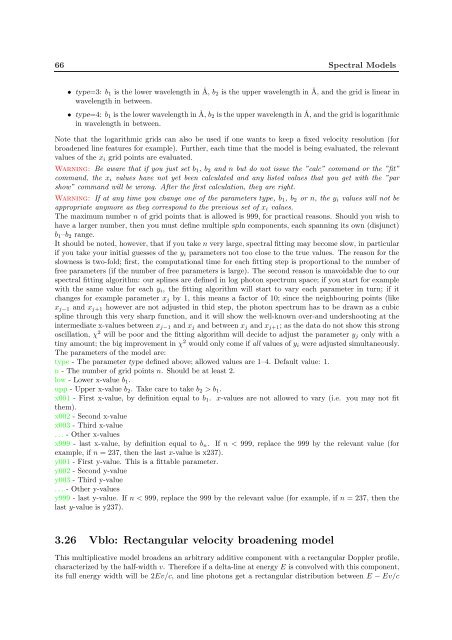SPEX User's Manual - SRON
SPEX User's Manual - SRON
SPEX User's Manual - SRON
You also want an ePaper? Increase the reach of your titles
YUMPU automatically turns print PDFs into web optimized ePapers that Google loves.
66 Spectral Models<br />
• type=3: b 1 is the lower wavelength in Å, b 2 is the upper wavelength in Å, and the grid is linear in<br />
wavelength in between.<br />
• type=4: b 1 is the lower wavelength in Å, b 2 is the upper wavelength in Å, and the grid is logarithmic<br />
in wavelength in between.<br />
Note that the logarithmic grids can also be used if one wants to keep a fixed velocity resolution (for<br />
broadened line features for example). Further, each time that the model is being evaluated, the relevant<br />
values of the x i grid points are evaluated.<br />
Warning: Be aware that if you just set b 1 , b 2 and n but do not issue the ”calc” command or the ”fit”<br />
command, the x i values have not yet been calculated and any listed values that you get with the ”par<br />
show” command will be wrong. After the first calculation, they are right.<br />
Warning: If at any time you change one of the parameters type, b 1 , b 2 or n, the y i values will not be<br />
appropriate anymore as they correspond to the previous set of x i values.<br />
The maximum number n of grid points that is allowed is 999, for practical reasons. Should you wish to<br />
have a larger number, then you must define multiple spln components, each spanning its own (disjunct)<br />
b 1 –b 2 range.<br />
It should be noted, however, that if you take n very large, spectral fitting may become slow, in particular<br />
if you take your initial guesses of the y i parameters not too close to the true values. The reason for the<br />
slowness is two-fold; first, the computational time for each fitting step is proportional to the number of<br />
free parameters (if the number of free parameters is large). The second reason is unavoidable due to our<br />
spectral fitting algorithm: our splines are defined in log photon spectrum space; if you start for example<br />
with the same value for each y i , the fitting algorithm will start to vary each parameter in turn; if it<br />
changes for example parameter x j by 1, this means a factor of 10; since the neighbouring points (like<br />
x j−1 and x j+1 however are not adjusted in thid step, the photon spectrum has to be drawn as a cubic<br />
spline through this very sharp function, and it will show the well-known over-and undershooting at the<br />
intermediate x-values between x j−1 and x j and between x j and x j+1 ; as the data do not show this strong<br />
oscillation, χ 2 will be poor and the fitting algorithm will decide to adjust the parameter y j only with a<br />
tiny amount; the big improvement in χ 2 would only come if all values of y i were adjusted simultaneously.<br />
The parameters of the model are:<br />
type - The parameter type defined above; allowed values are 1–4. Default value: 1.<br />
n - The number of grid points n. Should be at least 2.<br />
low - Lower x-value b 1 .<br />
upp - Upper x-value b 2 . Take care to take b 2 > b 1 .<br />
x001 - First x-value, by definition equal to b 1 . x-values are not allowed to vary (i.e. you may not fit<br />
them).<br />
x002 - Second x-value<br />
x003 - Third x-value<br />
. . . - Other x-values<br />
x999 - last x-value, by definition equal to b n . If n < 999, replace the 999 by the relevant value (for<br />
example, if n = 237, then the last x-value is x237).<br />
y001 - First y-value. This is a fittable parameter.<br />
y002 - Second y-value<br />
y003 - Third y-value<br />
. . . - Other y-values<br />
y999 - last y-value. If n < 999, replace the 999 by the relevant value (for example, if n = 237, then the<br />
last y-value is y237).<br />
3.26 Vblo: Rectangular velocity broadening model<br />
This multiplicative model broadens an arbitrary additive component with a rectangular Doppler profile,<br />
characterized by the half-width v. Therefore if a delta-line at energy E is convolved with this component,<br />
its full energy width will be 2Ev/c, and line photons get a rectangular distribution between E − Ev/c

















